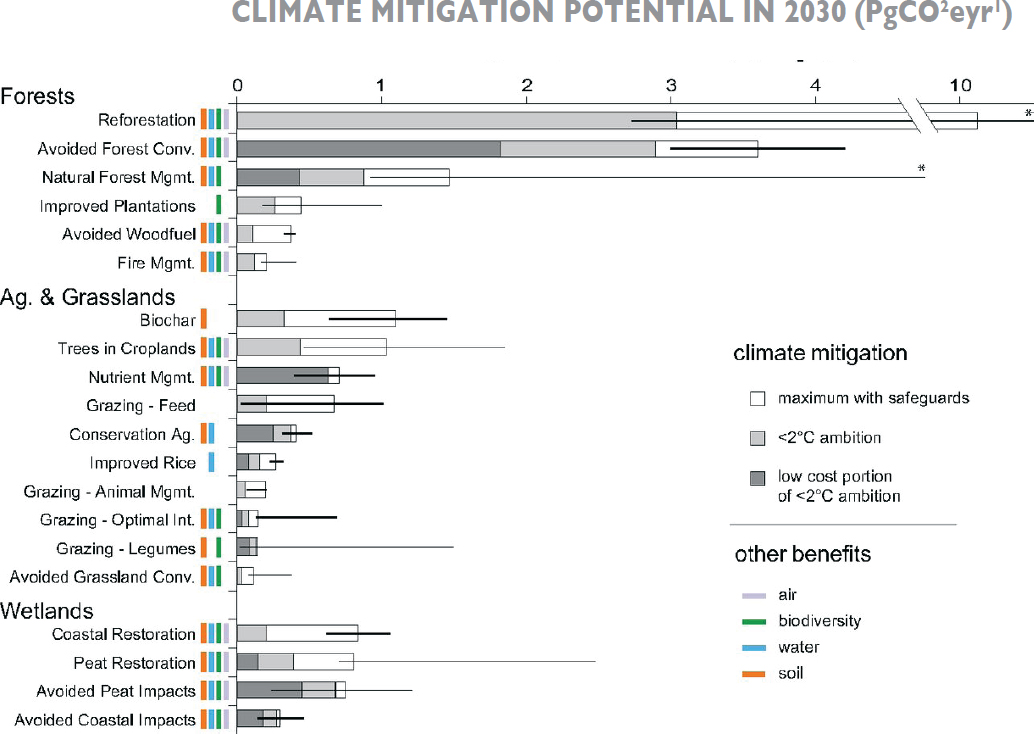3 Ecosystems as a Climate Solution
Nature-based solutions are actions to protect, sustainably manage, and restore natural or modified ecosystems. Such actions address societal challenges effectively and adaptively, simultaneously providing human well-being and biodiversity benefits.30 These solutions can result in climate-related benefits such as increases in carbon storage or the avoidance of greenhouse gas emissions. Examples of nature-based solutions that provide climate benefits include reforestation, avoided deforestation, coastal wetland restoration, and agricultural soil management. As the importance of ecosystems in addressing the drivers and impacts of climate change has become better recognized, there has been increased attention to nature-based solutions and how they can be implemented to benefit society.
ECOSYSTEMS AND CLIMATE CHANGE MITIGATION
Ecosystems mitigate climate change by removing the greenhouse gas carbon dioxide from the atmosphere. In recent years, roughly a quarter of the carbon dioxide emitted by human activities (due largely to fossil fuel burning and land use change) has been taken up and stored in the plants and soils of terrestrial ecosystems.31 In this way, ecosystems act as carbon “sinks.” As greenhouse gas concentrations continue to rise in the atmosphere, some researchers are exploring ways to manage ecosystems to enhance these carbon sinks beyond the capacity they have exhibited in the past.
___________________
30 See https://www.iucn.org/commissions/commission-ecosystem-management/our-work-nature-based-solutions, (accessed September 11, 2019).
31 Le Quéré, C., R. M. Andrew, P. Friedlingstein, S. Sitch, J. Hauck, J. Pongratz, P. A. Pickers, J. I. Korsbakken, G. P. Peters, J. G. Canadell, A. Arneth, V. K. Arora, L. Barbero, A. Bastos, L. Bopp, F. Chevallier, L. P. Chini, P. Ciais, S. C. Doney, T. Gkritzalis, D. S. Goll, I. Harris, V. Haverd, F. M. Hoffman, M. Hoppema, R. A. Houghton, G. Hurtt, T. Ilyina, A. K. Jain, T. Johannessen, C. D. Jones, E. Kato, R. F. Keeling, K. K. Goldewijk, P. Landschützer, N. Lefèvre, S. Lienert, Z. Liu, D. Lombardozzi, N. Metzl, D. R. Munro, J. E. M. S. Nabel, S. I. Nakaoka, C. Neill, A. Olsen, T. Ono, P. Patra, A. Peregon, W. Peters, P. Peylin, B. Pfeil, D. Pierrot, B. Poulter, G. Rehder, L. Resplandy, E. Robertson, M. Rocher, C. Rödenbeck, U. Schuster, J. Schwinger, R. Séférian, I. Skjelvan, T. Steinhoff, A. Sutton, P. P. Tans, H. Tian, B. Tilbrook, F. N. Tubiello, I. T. van der Laan-Luijkx, G. R. van der Werf, N. Viovy, A. P. Walker, A. J. Wiltshire, R. Wright, S. Zaehle, and B. Zheng. 2018. Global carbon budget 2018. Earth System Science Data 10(4):2141-2194. DOI:10.5194/essd-10-2141-2018.

Enhanced mitigation potential of many ecosystem types can be achieved through management practices that promote greater carbon uptake and storage. Recent efforts have explored this potential, along with the costs and risks associated with management across a wide range of ecosystem types, to determine feasibility of implementation at scales likely to have a measurable impact on climate change.32,33
Ecosystem management alone is not enough to address the challenge of rising carbon emissions, but it can play a significant role.34 Research on carbon uptake
___________________
32 NASEM. 2019. Negative Emissions Technologies and Reliable Sequestration: A Research Agenda. Washington, DC: The National Academies Press. DOI: https://doi.org/10.17226/25259.
33 The Royal Society. 2018. Greenhouse Gas Removal. London, United Kingdom: Royal Society. https://royalsociety.org/-/media/policy/projects/greenhouse-gas-removal/royal-society-greenhouse-gas-removal-report-2018.pdf, accessed May 22, 2019.
34 Anderson, C. M., R. S. DeFries, R. Litterman, P. A. Matson, D. C. Nepstad, S. Pacala, W. H. Schlesinger, M. R. Shaw, P. Smith, C. Weber, and C. B. Field. 2019. Natural climate solutions are not enough. Science 363(6430):933-934. DOI: 10.1126/science.aaw2741.
and mitigation presented at the forum suggested that a wide range of ecosystem types have the potential to increase carbon storage and/or avoid greenhouse gas emissions with conservation, restoration, and/or improved land management actions (see Figure 2).35 Ecosystem management in this study includes reforesting areas where trees have been cut down, avoiding the conversion of forests to other land uses, and better management of natural forests. Increased carbon storage can also occur in agricultural systems, where better nutrient management may be the most cost-effective approach, and other practices (such as the addition of biochar) may have the greatest potential to improve carbon uptake and storage. In wetlands, protecting and restoring peatlands and coastal restoration may also provide improved, cost-effective carbon uptake. Coastal ecosystems such as seagrass beds, mangrove swamps, and salt marshes also act as significant carbon sinks, and ocean organisms act as a biological pump transferring carbon from surface waters into the deep ocean carbon sink.36
Throughout the forum, participants discussed the tradeoffs when making decisions to manage ecosystems for mitigation purposes. For instance, the production and use of biofuels with carbon capture and storage can have a negative impact on biodiversity and occupy large areas of land needed to grow food. The challenges of implementation at different scales and the influence of how those scales affect social issues (e.g., equity and jobs), political decisions, and institutional questions were also discussed. Key questions moving forward include “how can barriers be identified and overcome?” For further discussion, see Chapter 4.
___________________
35 Griscom, B. W., J. Adams, P. W. Ellis, R. A. Houghton, G. Lomax, D. A. Miteva, W. H. Schlesinger, D. Shoch, J. V. Siikamäki, P. Smith, P. Woodbury, C. Zganjar, A. Blackman, J. Campari, R. T. Conant, C. Delgado, P. Elias, T. Gopalakrishna, M. R. Hamsik, M. Herrero, J. Kiesecker, E. Landis, L. Laestadius, S. M. Leavitt, S. Minnemeyer, S. Polasky, P. Potapov, F. E. Putz, J. Sanderman, M. Silvius, E. Wollenberg, and J. Fargione. 2017. Natural climate solutions. Proceedings of the National Academy of Sciences of the United States of America 114(44):11645-11650. DOI: 10.1073/pnas.1710465114.
36 Boyd, P. W., H. Claustre, M. Levy, D. A. Siegel, and T. Weber. 2019. Multi-faceted particle pumps drive carbon sequestration in the ocean. Nature 568(7752):327-335. DOI:10.1038/s41586-019-1098-2.

SOURCE: Griscom, B. W., J. Adams, P. W. Ellis, R. A. Houghton, G. Lomax, D. A. Miteva, W. H. Schlesinger, D. Shoch, J. V. Siikamäki, P. Smith, P. Woodbury, C. Zganjar, A. Blackman, J. Campari, R. T. Conant, C. Delgado, P. Elias, T. Gopalakrishna, M. R. Hamsik, M. Herrero, J. Kiesecker, E. Landis, L. Laestadius, S. M. Leavitt, S. Minnemeyer, S. Polasky, P. Potapov, F. E. Putz, J. Sanderman, M. Silvius, E. Wollenberg, and J. Fargione. 2017. Natural climate solutions. Proceedings of the National Academy of Sciences of the United States of America 114(44): 11645-11650. DOI: 10.1073/pnas.1710465114.
ECOSYSTEMS AND SOCIETAL ADAPTATION TO CLIMATE CHANGE
Sustaining or expanding critical ecosystem services that foster human well-being can help society adapt to climate change. These nature-based solutions have often been considered at relatively small scales with unique goals in mind based on the services needed at a given location and the specific local climate change impacts.

Coastal and marine ecosystems are located at the frontlines of climate change effects related to sea level rise and shoreline impacts from increases in extreme weather. Healthy wetlands and coral reefs may be able to keep pace with sea level rise, providing low-cost coastal protection that is self-repairing (by maintaining a positive net accretion) while also supporting fisheries that can sustain human livelihoods. Coastal ecosystems can reduce wave energy, stabilize shorelines, reduce erosion, trap debris, and protect the productivity of inland areas. Coral reefs, kelp forests, seagrass beds, and mangrove swamps contribute to erosion control and storm protection, with additional benefits of preservation of cultural heritage, education, food production, and tourism.37
Working terrestrial landscapes can also be managed to provide multiple benefits. For example, in Monteregie, a suburbanizing agricultural region just outside Montreal, Canada, a multi-stakeholder partnership is working to prioritize and plan for future land uses and ecosystem service needs.38 Benefits being considered include climate regulation, carbon storage, aesthetic beauty and nature appreciation, fuel wood, maple syrup production, deer hunting, pest regulation, water quality regulation, and food production. By understanding community needs and service options, planners can maximize benefits, understand the tradeoffs of the decisions they make, and ensure that resilience to future climate change can be incorporated into land use decisions.
Nature-based solutions that provide a biodiversity- based bio-economy are also being explored. In the Amazon, efforts are under way to provide viable value chains for products
___________________
37 Gattuso, J.-P., A. K. Magnan, L. Bopp, W. W. L. Cheung, C. M. Duarte, J. Hinkel, E. Mcleod, F. Micheli, A. Oschlies, P. Williamson, R. Billé, V. I. Chalastani, R. D. Gates, J.-O. Irisson, J. J. Middelburg, H.-O. Pörtner, and G. H. Rau. 2018. Ocean solutions to address climate change and its effects on marine ecosystems. Frontiers in Marine Science 5(337). DOI:10.3389/fmars.2018.00337.
38 Bennett, E. M., C. Albert, A. Ball, J. Cardille, K. Dancose, S. Delmotte, A. Gonzalez, H. Hui-Huang, M. Lechowicz, K. Liss, R. Kipp, D. Maguire, S. Mahajan, M. Mitchell, K. Teixeira-Martins, C. Raudsepp-Hearne, D. Renard, J. Rhemtulla, L. Taliana, M. Terrado, and C. Ziter. The Montérégie Connection: Understanding How Ecosystems Can Provide Resilience to the Risk of Ecosystem Service Change. In Atlas of Ecosystem Services. M. Schröter, A. Bonn, S. Klotz, R. Seppelt, and C. Baessler, eds. Cham, Switzerland: Springer.
derived from ecosystems such as food, nutraceuticals, cosmetics, fragrances, pharmaceuticals, and industrial oils. These efforts have a goal of creating a new sustainable development paradigm for tropical forests where the value of the ecosystems and attention to management may help to reduce ecosystem changes linked to climate change and human activities such as deforestation, mining, and dam construction.
The utilization of nature-based solutions in cities plays an important role in societal adaptation to climate change. Some climate change impacts (e.g., hotter daily average and night-time temperatures, as well as extended heat waves, droughts, and flooding) are exacerbated in cities due to particular attributes of urban systems, such as the high impervious cover of cities, concentrations of waste heat and pollution, interdependent infrastructure, the concentration of people and infrastructure, and socioeconomic disparities. Nature-based solutions in cities include increased tree canopy cover, protection or restoration of streams, development of urban stormwater management structures, construction of green roofs and walls, increased area devoted to parks and open spaces, and restored coastal ecosystems to serve as protection.39 In addition to the climate benefits of nature-based solutions in cities, these efforts can promote biodiversity, improved human mental and physical health, and other social benefits such as reduced crime and increased social cohesion.40

Because nature-based solutions can provide a range of different benefits based on selected management strategies, prioritization decisions will need to be made to maximize the most favorable services for the given situation or location. This could result in tradeoffs whereby some services cannot be met or other concessions need to be made. For example, vegetation can provide a variety of ecosystem services, but in some areas it can place demands on scarce water supplies. In some cases, climatic and other stressors, including extreme events, could eventually overpower nature-based solutions. This possibility will require that combinations of nature-based and engineered solutions—so called green-gray or hybrid approaches—be considered and implemented.
“Solutions are going to have to be things that both improve human well-being and are good climate solutions.”
—ELENA BENNETT, McGill University
__________________
39 Ziter, C. D., E. J. Pedersen, C. J. Kucharik, and M. G. Turner. 2019. Scale-dependent interactions between tree canopy cover and impervious surfaces reduce daytime urban heat during summer. Proceedings of the National Academy of Sciences of the United States of America 116(15):7575-7580. DOI:10.1073/pnas.1817561116.
40 Engemann, K., C. B. Pedersen, L. Arge, C. Tsirogiannis, P. B. Mortensen, and J.-C. Svenning. 2019. Residential green space in childhood is associated with lower risk of psychiatric disorders from adolescence into adulthood. Proceedings of the National Academy of Sciences of the United States of America 116(11):5188-5193. DOI:10.1073/pnas.1807504116.






